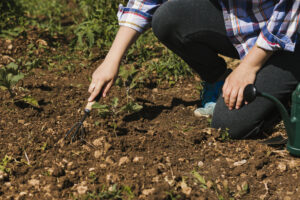Soil analysis techniques that offer accurate test results must be used for fertilizer recommendations. For nitrogen (N) and Sulphur (S), the soil analysis results are reported in lb/ac. In the case of phosphorous (P), potassium (K), and micronutrients, the analysis results are reported in PPM (parts per million).
Before giving any soil test fertilizer recommendations, there are different key elements to note when reviewing each soil property’s results:

Nitrogen –
Water soluble nitrate-nitrogen measured to 24” depth. When the samples are taken to less than 24” depth, a conversion value is used to estimate the amount that is not measured. This estimation might be affected due to the weather conditions and the soil zone. Therefore, it is recommended that the sample is taken to full 24” depth.
Phosphorous –
When it comes to the soil test fertilizer recommendations, the Olsen technique helps to measure the extractable Phosphorous in the top 6-inch depth. It is well suited for alkaline soils. There are some laboratories that use acetic fluoride or modified Kelowna test.
Potassium (K) –
The ammonium acetate exchange technique is used to measure the exchangeable K in the top 6” depth. The acetic fluoride test also includes ammonium acetate and is a sustainable technique.
Sulphur (S) –
Water soluble sulphate-sulphur measured to 24” depth.
Copper, Zinc, Manganese, Iron –
Diethylene triamine Penta acetic acid (DTPA) extractable in the top 6” depth.
Soil pH –
Measurements of soil pH depend on the analytical methods used. Using a 1:2 soil-to-calcium chloride solution will lessen the interference from soil salts, and it is used in scientific and soil survey characterization. Most commercial labs use a 1:1 or 2:1 soil-to-water ratio, which tends to increase the pH readings of soils by 0.5 units.
Salinity or Electrical Conductivity (EC) –
Soil test fertilizer recommendations include the determination of the salinity of the soil. The salinity measurement for research and soil survey characterization is determined by the saturated paste method, where enough water is added to the sample for saturating it without leaving free water. This reflects the salinity of the soil that occurs at the root surface. Most commercial labs use the 1:1 or 2:1 soil-to-water ratio method, and salinity levels will be nearly half of the saturated paste method. The electrical conductivity is determined in a 1:1 soil-to-water ratio generally multiplied by factor 2. The conversion is soil texture specific, and it can vary.
Plant Tissue Analysis
Plant tissue analysis is another essential element in soil test fertilizer recommendations. Plant tissue analysis measures the nutrient levels in growing crops. Test values are compared with established values for inadequate, adequate, and excess levels for each element and plant species. In this way, the nutritional health of the plant sample and the crop it represents can be easily determined. Also, the supply and availability of nutrients to crops throughout the growing season can be evaluated.
Plant tissue analysis is useful for evaluating fertilizer management practices and diagnosing nutrient-related crop production problems. Also, it helps in figuring out the nutrient levels in crops that might limit the top yield achievement, including the potential micronutrient problems. Just like soil testing, the validity and usefulness of plant tissue analysis depends on proper plant sampling and sample handling procedures. These include:
- Sampling crops from individual fields separately.
- Sampling proper plant parts at the proper growth stage. This is specific for individual crops and lab.
- Sampling an adequate number of plants from different locations in a field.
- Dry the samples as soon as possible after removing them from normal temperatures that don’t exceed 35 degrees Celsius.
- Make sure to avoid any contamination of the sample with fertilizer dust, cigarette ashes, and other substances.
SoilOptix® allows growers to dig deeper into their soil test results, and make more informed decisions based on the level of detail in their final maps. Contact the team at SoilOptix® to learn how you can get more out of your soil test fertilizer recommendations.
